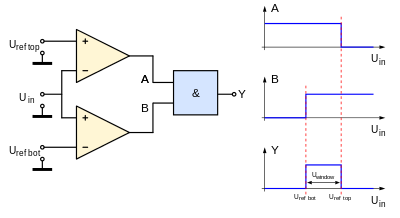Window detector

A window detector circuit, also called window comparator circuit or dual edge limit detector circuits is used to determine whether an unknown input is between two precise reference threshold voltages.[1] It employs two comparators to detect over-voltage or under-voltage.[2]
Each single comparator detects the common input voltage against one of two reference voltages, normally upper and lower limits.[3] Outputs behind a logic gate like AND detect the input as in range of the so-called "window" between upper and lower reference.
Window detectors are used in industrial alarms, level sensor and controls, digital computers and production-line testing.[citation needed]
Function[edit]
| Uin | A | B | Y |
|---|---|---|---|
| > Urefbot | 0 | 1 | 0 |
| < Ureftop | 1 | 0 | 0 |
| < Ureftop > Urefbot |
1 | 1 | 1 |
If Uin is greater than Urefbot and Uin is lower than Ureftop then both comparators' outputs will swing to the logical high and turn on the AND gate output.
See also[edit]
References[edit]
- ^ Ramón Pallás-Areny; John G. Webster (1999). Analog Signal Processing. John Wiley & Sons. pp. 287–. ISBN 978-0-471-12528-0.
- ^ Bali (2008). Linear Integrated Circuits. Tata McGraw-Hill Education. pp. 155–. ISBN 978-0-07-064807-4.
- ^ Steve Ciarcia (1990). Ciarcia's Circuit Cellar. Circuit Cellar. pp. 1–. ISBN 978-0-07-010969-8.
Further reading[edit]
- Tietze, Ulrich; Schenk, Christoph (1993). Halbleiter-Schaltungstechnik (10th ed.). Springer. pp. 190–191. ISBN 3-540-56184-6.
